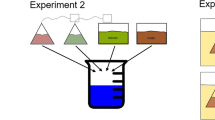Abstract
Background, aim, and scope
The aim of this review was to assess the degree to which recent litter bag studies performed between 2002 and 2004 have followed the recommendations laid down in the ‘Effects of plant protection products on functional endpoints in soil (EPFES)’ guidance document and the Organisation for Economic Co-Operation and Development (OECD) Guidance Document on the Breakdown of Organic Matter in Litter bags (OECD, Guidance document on the breakdown of organic matter in litter bags, OECD series on testing and assessment, no 56, 36 pp, 2006), which can be required under European Union (EU) Directive 91/414/EEC (EU, Off J Eur Union, L230:1–32, 1991) for assessing the effect of plant protection products on non-target soil macro-organisms which contribute to the breakdown of organic matter.
Materials and methods
The current review covers the analysis of key parameters of the litter bag method of a total of 29 litter bag studies conducted by six European Crop Protection Association companies.
Results
The two validity criteria [i.e. 60% mass loss at the end of the study in the control and a maximum coefficient of variation of 40% for mass loss in the control plots (n = 6) during the first 6 months of the test] were met in all of the studies reviewed. In over half of the studies, more than 60% mass loss was reached in the control litter bags after about 6 months. Statistically significant effects on organic matter breakdown due to plant protection products were repeatedly observed during the first few months of the study conduct, including effects >10% up to >25% compared to the control.
Discussion
The survey of 29 study reports—performed from May 2002 to May 2004—showed that litter bag studies are generally being performed following the ‘EPFES’ guidance document and the OECD guidance document no. 56. Transient, statistically significant effects >10% up to >25% compared to the control were determined repeatedly during the first few months of the study conduct, thus clearly indicating the sensitivity of the litter bag test system.
Conclusions and perspectives
The litter bag study design is a valuable test system for the risk assessment of plant protection products on non-target soil macro-organisms which contribute to the breakdown of organic matter under EU Directive 91/414/EEC (EU, Off J Eur Union, L230:1–32, 1991). In general, it can be concluded that the litter bag test, as proposed by EPFES and the OECD guidance document, provides an integrative answer on the potential effects of plant protection products on organic matter breakdown in soil and can be continued to be used if the studies follow the recommendations as presented in the guidance documents closely.


Similar content being viewed by others
References
Cadisch G, Giller KE (eds) (1997) Driven by nature. Plant litter quality and decomposition. CAB International, Wallingford, UK, pp 409
EU (European Union) (1991) Council directive concerning the placing of plant protection products on the market (91/414/EEC). Off J Eur Union L230:1–32
Frampton G, Jones S, Knacker TH, Förster B, Römbke J, Filser J, Mebes H (2002) Assessing the effects of pesticides on non-target soil organisms involved in the degradation of organic matter. SETAC Globe 3:25–26
Knacker TH, Förster B, Römbke J, Frampton G (2003) Assessing the effects of plant protection products on organic matter breakdown in arable fields—litter decomposition test systems. Soil Bio Biochem 35:1269–1287
Lavelle P, Bignell D, Lepage M, Wolters V, Roger P, Ineson P, Heal OW, Dhillion S (1997) Soil function in a changing world: the role of invertebrate ecosystem engineers. Eur J Soil Biol 33:159–193
OECD (2006) Guidance document on the breakdown of organic matter in litter bags. OECD series on testing and assessment. No 56, 36 pp
Römbke J, Heimbach F, Hoy S, Kula C, Scott-Fordsmand J, Sousa P, Stephenson G, Weeks J (eds) (2003) Effects of plant protection products on functional endpoints in soil (EPFES). SETAC, Lisbon, 24–26 April 2002, 92 pp
Swift MJ, Heal OW, Anderson JM (1979) Decomposition in terrestrial ecosystems. Studies in Ecology, Vol. 5. Blackwell Scientific Publication, Oxford, UK, p 372
Acknowledgement
We thank the six ECPA companies (namely BASF AG, Bayer CropScience AG, Dow AgroSciences, DuPont de Nemours, Makhteshim Agan Industries and Syngenta Crop Protection AG) for providing the 29 litter bag study reports, ECPA for funding this review, and three reviewers for their valuable comments.
Author information
Authors and Affiliations
Corresponding author
Rights and permissions
About this article
Cite this article
Dinter, A., Coulson, M., Heimbach, F. et al. Technical experiences made with the litter bag test as required for the risk assessment of plant protection products in soil. J Soils Sediments 8, 333–339 (2008). https://doi.org/10.1007/s11368-008-0028-y
Received:
Accepted:
Published:
Issue Date:
DOI: https://doi.org/10.1007/s11368-008-0028-y




